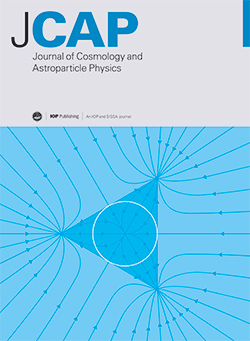被德能型暗物质晕包围的施瓦兹柴尔德黑洞的阴影、ISCO、准正常模式、霍金谱、弱引力透镜和参数估计
IF 5.9
2区 物理与天体物理
Q1 ASTRONOMY & ASTROPHYSICS
Journal of Cosmology and Astroparticle Physics
Pub Date : 2025-03-21
DOI:10.1088/1475-7516/2025/03/054
引用次数: 0
摘要
我们考虑了嵌入德能(1,4,0)型暗物质光环(DDM)中的施瓦兹柴尔德黑洞(BH),该光环除了质量M之外还有两个附加参数--核心半径rs和核心密度ρs。我们分析了DDM黑洞周围的事件视界、光子轨道和ISCO,并强调了DDM参数对它们的影响。我们的研究发现,暗物质(DM)的存在会对光子轨道半径、最内层稳定圆形轨道(ISCO)和事件穹界产生有利影响。我们找到了大质量粒子在 DDM BH 周围类时间测地线上的比能量和角动量表达式,并研究了它们对 DDM 参数的依赖性。我们展示了不同内核密度和半径值下的 BH 阴影,发现被 DDM(SDDM)包围的施瓦兹柴尔德 BH 所投下的阴影要大于真空中的施瓦兹柴尔德 BH(SV)。接着,我们利用六阶 WKB 方法研究了准正常模式(QNMs),利用半解析边界方法研究了灰体因子,并研究了标量和电磁扰动的霍金谱。发现核心密度和半径对 QNMs 有显著影响。由于标量扰动和电磁扰动的 QNMs 有很大不同,我们可以根据 QNM 观察结果将两者区分开来。灰度因子会随着核心密度和半径的增加而增加,而霍金辐射的功率则会因为DM的存在而受到不利影响。然后,我们利用高斯-波内特定理对弱引力透镜进行研究,并得到带有高阶修正项的偏转角。在这里,我们看到偏转角因 DM 而增强。最后,我们利用 EHT 报告的 M87*、Keck 和 VLTI 天文台报告的 SgrA* 与施瓦兹柴尔德的偏差 δ 来衡量我们模型的可行性。结果发现我们的模型与观测结果一致。这使得我们的星系中心有可能被 DDM 所包围。本文章由计算机程序翻译,如有差异,请以英文原文为准。
Shadow, ISCO, quasinormal modes, Hawking spectrum, weak gravitational lensing, and parameter estimation of a Schwarzschild black hole surrounded by a Dehnen type dark matter halo
We consider Schwarzschild black hole (BH) embedded in a Dehnen-(1,4,0) type dark matter halo (DDM) with two additional parameters — core radius rs and core density ρs apart from mass M. We analyze the event horizon, photon orbits, and ISCO around DDM BHs and emphasize the impact of DDM parameters on them. Our study reveals that the presence of dark matter (DM) favourably impacts the radii of photon orbits, the innermost stable circular orbit (ISCO), and the event horizon. We find the expressions for specific energy and angular momentum for massive particles in time-like geodesics around DDM BH and investigate their dependence on DDM parameters. We display BH shadows for various values of core density and radius that reveal larger shadows cast by a Schwarzschild BH surrounded by DDM (SDDM) than a Schwarzschild BH in vacuum (SV). We then move on to study quasinormal modes (QNMs) with the help of the 6th order WKB method, the greybody factor using the semi-analytic bounds method, and the Hawking spectrum for scalar and electromagnetic perturbations. Core density and radius are found to have a significant impact on QNMs. Since QNMs for scalar and electromagnetic perturbations differ significantly, we can differentiate the two based on QNM observation. The greybody factor increases with core density and radius, whereas, the power emitted as Hawking radiation is adversely impacted by the presence of DM. We then study the weak gravitational lensing using the Gauss-Bonnet theorem and obtain the deflection angle with higher-order correction terms. Here, we see the deflection angle gets enhanced due to DM. Finally, we use bounds on the deviation from Schwarzschild, δ, reported by EHT for M87*, Keck, and VLTI observatories for SgrA* to gauge the viability of our model. Our model is found to be concordant with observations. This leads to the possibility of our galactic center being surrounded by DDM.
求助全文
通过发布文献求助,成功后即可免费获取论文全文。
去求助
来源期刊

Journal of Cosmology and Astroparticle Physics
地学天文-天文与天体物理
CiteScore
10.20
自引率
23.40%
发文量
632
审稿时长
1 months
期刊介绍:
Journal of Cosmology and Astroparticle Physics (JCAP) encompasses theoretical, observational and experimental areas as well as computation and simulation. The journal covers the latest developments in the theory of all fundamental interactions and their cosmological implications (e.g. M-theory and cosmology, brane cosmology). JCAP''s coverage also includes topics such as formation, dynamics and clustering of galaxies, pre-galactic star formation, x-ray astronomy, radio astronomy, gravitational lensing, active galactic nuclei, intergalactic and interstellar matter.
 求助内容:
求助内容: 应助结果提醒方式:
应助结果提醒方式:


